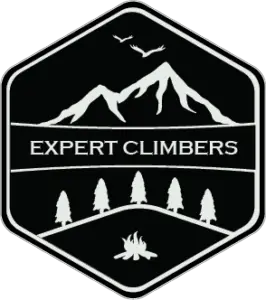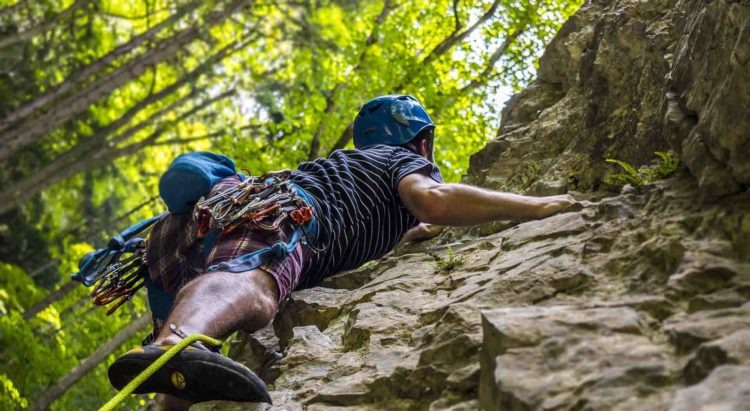Most people seem to have this strange perception that just because I go climbing, I’m some sort of muscle-machine. But the truth of it is, if you’re fit enough to climb up a ladder, then you can climb up a climbing wall or a cliff.
So, how strong do I have to be to go climbing? The answer is really not that strong.
Climbing has much more to do with technique rather than the strength you have. So, it’s by perfecting your technique that you’ll have better climbs. And hey, even if you can’t handle a ladder (plenty of climbers are initially afraid of heights, or rather, the fear of falling from those heights) but can walk, run, cycle, or intermittently weight lifting, you can totally go climbing. You’ll just have to learn a few things first!
Technique Is More Important Than Strength
Most people new to climbing are really surprised that you don’t even need extreme upper body strength to climb. I certainly was. It’s all about the techniques rather than brute force. The first time you climb up the wall, you’ll be surprised just how much your legs will ache afterward. Your legs will do most of the work, so you don’t need gigantic biceps to be a great climber.
It’s also a mental exercise, which is why, you’ll have to strategize your next move before you begin climbing. Starting out, you’ll be at your local climbing wall. You can test this technique out there by scoping out the hand- and footholds. Even though it’s easy to spot them at the gym, on the rock it’s not. Train your eyes to see chalk marks and foot scuffs, then visualize the route. Some of the biggest challenges I’ve encountered while climbing are those that involved problem-solving on the fly. What worked for me was to find my center of calm and refocus on it to be successful with my climb. It sounds exhausting, but it’s quite exhilarating.
Another thing you should know is that proper climbing technique requires balance rather than strength. So many new climbers (which was me just a few years ago) tend to “hug” the wall or the rock. I did it, and likely, you will too, when you first get up there. But you have to break yourself of this habit because it removes your weight off your feet, which will throw you off balance. Keeping your balance in check is key! So, I recommend you do work on exercises that promote balance (more on that shortly).
As I said, it’s not about having big, bulky arms and a lot of upper-body strength when you climb. It’s more about agility and a combination of legs, feet, and balance. Concentrate on pushing your legs on the footholds and pulling, using your arms and hands. It’s not that you won’t be using your upper body at all, but rather, it’s there to help you find that balance. Practice this when you’re on the wall, and you’ll see it’s a smoother experience.
Feet are also important for mastering proper climbing technique. Toeing is using the toe of your climbing shoe for a foothold, while edging uses the inner and outer edges of your shoe. Smearing is when you put as much of your shoe rubber on there as you can, like when you’re climbing a slab, which relies on friction to hold your foot in place. I can’t stress enough how important these three-foot positions are. Practice them at the indoor climbing gym.
Hands are where you get to be creative though. There are lots of crimps and open-hand grips that you’ll find. This goes with the mental bit, and as you climb, keep remapping the surface to discover the best handholds. Again, at the climbing wall, it’s more obvious, but establish this technique there, to be successful when climbing outdoors. You’ll want to look horizontally as well as vertically to scout out edges, crimps, and pinches that you can grab.
Also, a common mistake newbies make is gripping that hold too tightly. Keep those hands loose. You’ll just waste your energy and won’t be able to get as far as you wanted before resting.
Start Out By Bouldering In A Climbing Gym
When you’ve decided to start venturing into the climbing world, you’ll likely feel safest at the gym. It’s silly to think that your first time climbing you can (or even should!) conquer a mountain. Most people go for indoor bouldering first. You can do this at the gym, where, if you fall off, you simply drop to the ground where a bunch of thick mats are waiting to catch you. The first time it happens is much less scary than you think, even if you’re afraid of heights.
The more this happens, the more you develop your climbing technique. You get those critical thinking skills, as well as learn how to get the right foot- and handholds. You’ll also start to come into your own with that burning sensation you get in your quads when you’re first getting used to this sport. Skills need to be cultivated over time by bouldering and then in the great outdoors; where you get familiar with the types of ropes, carabiners, pitons and all that you’ll be relying in. For now, take it one step at a time and focus on those techniques rather than the strength you have (or don’t have). You’ll learn how to make them all work for you in due time.
Another thing I have to recommend here is to get in tune with your balance. As I said before, balance is one of those things that is paramount to climbing. You’ll see strong, muscular guys falling time after time due to their lack of balance and agility: while women will outpace them because they’ve taken yoga or a dance class. For me, I began taking yoga tangentially. It was actually a work-thing because the stress of it and the hour-long sitting was making me feel sick. I tried out yoga to help release the constant stress I was under, and I found it helped me zero-in on my balancing skills. Even using a balancing board in your home for 10 minutes a day can severely improve your skills. One of my friends does this in his corner office every day, while he makes important phone calls.
Pick An Easy Climbing Grade You Can Start With
Not all climbing is advanced. There is a plentitude of grades. And I’m sure you’ll find easy climbs at your climbing gym. Even some crags are easy climbs. They’re really just like a ladder. Going with what’s easy first is the only way you’ll master climbing.
Don’t think just because you’re big and tough that you can handle 5.15 levels from the start. You’ll just wind up getting hurt. Climbing is all about being humble and working your way up. And if you don’t believe me, go right for the advanced level at the gym, and you’ll see exactly what I mean, you’ll find yourself begging your belayer to get you down.
Besides, if you keep your climbs easy, you’ll get your technique in place right from the start. While climbing is certainly harder than going for a run, the more you do it and the more you get familiar with, the easier grades, the more you can focus on the mentality of it and striving for crushing your old goals.
For levels like V0 or V1, if you can climb a ladder, you’ll most definitely be able to climb these. You don’t need the strength but the techniques and discipline to handle it. Once you work your way up to advanced levels though, you’ll have to use more strength. Much of that will come from your legs, but you may find you can only use one hand to pull yourself up.
I know that seems insurmountable at this point, but you’re getting ahead of yourself. Just focus on the immediate situation, which is what rock climbing really trains you to do anyway. You can’t think about anything else while you’re on the crag except your strategy for how you’re going to make the climb. You’re busy mentally mapping out the route, scouting those holds, and living in the moment.
That’s what climbing is about, living in the moment and focusing on the present.
A little bit of motivation
I know it seems like an awful lot to take in. Some people look up a climbing wall or crag like I did and cringe in terror. Others want to run up to the top. But all of us, afraid or not, have to start at the bottom.
Most of the world’s greatest climbers started out bouldering either indoors or outdoors. It’s a safe haven where you can get your techniques in place and learn the best practices. You’ll soon have a handle, pun intended, on the sport and be able to progress. If you do any other sports, you know that you can’t expect to be number one on your first day.
Focus on being your own personal best by learning all you can, putting it into action, and growing more and more with every climb. You must also put in the time as often as you can to get better.
I once started on a climbing wall, scared out of my wits. Now, I climb 5.11a. I built up to that, and I learned to have fun doing it. Don’t forget about the fun. If you’re not having fun while climbing, then you’re most definitely doing something wrong!
Obviously, you’re here reading this for a reason so go with it. Take that inner drive you find when you want to do something and make it work for you one foot- and handhold at a time.
Conclusion
In short, climbing doesn’t require superhuman strength. It requires thoughtfulness, mindfulness, strategizing in the moment, and learning a few techniques that relate to your hands and feet. It requires more lower-body strength, particularly in your quads, to propel you up the wall.
Starting off low and easy is how you learn to master the techniques that will make you a successful climber. You can’t expect to go out to a crag on your first climb ever and crush it, no matter how fit you might be. It’s all practice, building endurance, and getting familiar with all the intricacies of the climb.
Keep practicing at the climbing wall and work on cultivating your balance which is crucial. Learning to stay balanced will make you a better athlete.


